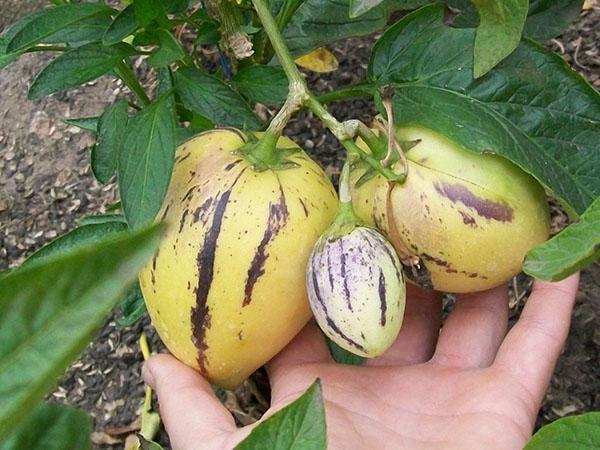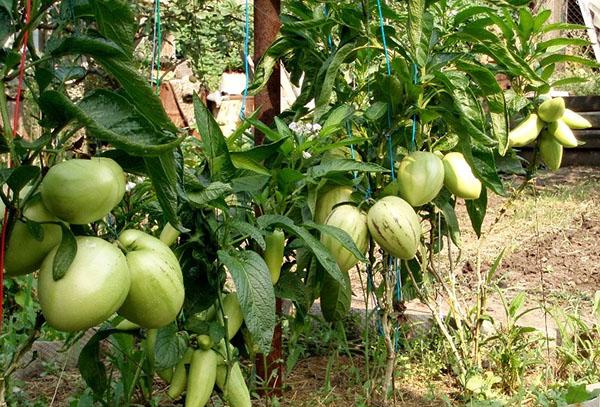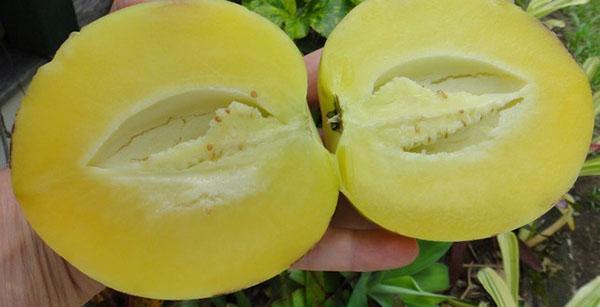Pepino plant or melon pear for a summer cottage
 The fruits of a small evergreen shrub from South America are quite edible and resemble a small melon or cucumber. The plant pepino or melon pear grows more than a meter. In the conditions of central Russia, it is grown in winter gardens, heated greenhouses, greenhouses. There will also be a place for it on the windowsill, since pepino does not require the creation of any special Agroconditions or complex measures during the growth process.
The fruits of a small evergreen shrub from South America are quite edible and resemble a small melon or cucumber. The plant pepino or melon pear grows more than a meter. In the conditions of central Russia, it is grown in winter gardens, heated greenhouses, greenhouses. There will also be a place for it on the windowsill, since pepino does not require the creation of any special Agroconditions or complex measures during the growth process.
Pepino or melon pear plant in Russia

A close acquaintance with the melon pear
 Pepino what is this plant? A small semi-lignified shrub, perennial with pleasant-tasting fruits. On household plots, it is grown in heated greenhouses, and at home - on a windowsill. Fruits vary in color, shape and size. Their mass is from 150 to 750 g. They can be elongated, oval and even round. Most of them are yellow with pronounced purple strokes. The yellowish pulp of a ripe fruit has a sweet and sour taste.
Pepino what is this plant? A small semi-lignified shrub, perennial with pleasant-tasting fruits. On household plots, it is grown in heated greenhouses, and at home - on a windowsill. Fruits vary in color, shape and size. Their mass is from 150 to 750 g. They can be elongated, oval and even round. Most of them are yellow with pronounced purple strokes. The yellowish pulp of a ripe fruit has a sweet and sour taste.
Since 92% of the fruits of the pepino or melon pear plant are water, they are very juicy. They contain:
- vitamin C;
- iron;
- pectin substances;
- carotene.
Vitamins A, B1, B2 and PP are present in large quantities - nicotinic acid, which is involved in many metabolic processes in the human body and the formation of enzymes. The stem and leaves of a melon pear resemble pepper, and its flowers, most of all, are similar to potato.
At the very beginning of development, the growth of seedlings is slow, approximately like that of an eggplant. But later, after landing in a permanent place, pepino is looked after in the same way as tomatoes. This is due to the fact that the plant belongs to the nightshade family, along with peppers, physalis, potatoes, tomatoes and eggplants. The aroma of ripe fruits is a bit exotic, sometimes reminiscent of melon and pear or mango, with a slight touch of strawberries.
Popular varieties of the pepino plant
 Many people ask: "What is pepino and how to grow it?" This plant is still unfamiliar to most gardeners. Pepino is successfully grown in Australia, Chile, Peru, Israel and other countries with a suitable climate. Dutch experts believe that with proper agricultural technology, up to 30 kg of crops can be obtained from an area of 1 m2 occupied by plantings. Thanks to the employees of the agricultural firm "Gavrish", who began to work on the breeding of melon pears, two varieties that have undergone adaptation to climatic conditions have appeared - "Ramses" and "Consuelo".
Many people ask: "What is pepino and how to grow it?" This plant is still unfamiliar to most gardeners. Pepino is successfully grown in Australia, Chile, Peru, Israel and other countries with a suitable climate. Dutch experts believe that with proper agricultural technology, up to 30 kg of crops can be obtained from an area of 1 m2 occupied by plantings. Thanks to the employees of the agricultural firm "Gavrish", who began to work on the breeding of melon pears, two varieties that have undergone adaptation to climatic conditions have appeared - "Ramses" and "Consuelo".
Variety "Consuelo"
 The variety obtained from the seedlings of the Latin American pepino. The bush without formation reaches a height of 1.5 m. With proper care, the fruits ripen 120 days after planting cuttings or seedlings in the ground. The fruits of this variety are heart-shaped. Their color is orange with dark lilac longitudinal stripes. The pulp is juicy, tasty, with a strong melon aroma. Fruit weight up to 580 g.
The variety obtained from the seedlings of the Latin American pepino. The bush without formation reaches a height of 1.5 m. With proper care, the fruits ripen 120 days after planting cuttings or seedlings in the ground. The fruits of this variety are heart-shaped. Their color is orange with dark lilac longitudinal stripes. The pulp is juicy, tasty, with a strong melon aroma. Fruit weight up to 580 g.
Pepino "Ramses"
 A variety bred from Israeli seedlings.The fruits begin to sing as early as 110 days after planting the seedlings in the garden. Their shape is cone-shaped, with a sharp top. Fruit color is orange. The pulp is lighter, sweetish, with a delicate melon aroma. Weight up to 1 kg.
A variety bred from Israeli seedlings.The fruits begin to sing as early as 110 days after planting the seedlings in the garden. Their shape is cone-shaped, with a sharp top. Fruit color is orange. The pulp is lighter, sweetish, with a delicate melon aroma. Weight up to 1 kg.
There are only 25 plant varieties grown in the world. Only two of them bear fruit fully in Russia and can grow even in Siberia.
In the southern regions of the Russian Federation and Ukraine, amateurs sometimes grow foreign varieties. For instance:
- "Gold";
- Valencia;
- "Bowls";
- Kendal and several others.
There are also vegetables among them, which are indispensable for various salads. Moreover, many fruits can be stored in cool conditions for up to 1.5 months.
Pepino or Melon Pear Plant: Growing Tips and Care
 To germinate melon pear seeds, you need to sow them in November or December. The seeds are small, the emergence of seedlings is possible even on the 30th day after sowing. However, experienced gardeners often get them earlier. The average seed germination capacity of the "Ramses" variety is 50%, and the "Consuelo" - about 80%.
To germinate melon pear seeds, you need to sow them in November or December. The seeds are small, the emergence of seedlings is possible even on the 30th day after sowing. However, experienced gardeners often get them earlier. The average seed germination capacity of the "Ramses" variety is 50%, and the "Consuelo" - about 80%.
 The seeds intended for germination are spread on a damp cloth and placed in a transparent jar. Cover tightly and put in a warm place. The temperature must be constant and not drop below 26 ° C.
The seeds intended for germination are spread on a damp cloth and placed in a transparent jar. Cover tightly and put in a warm place. The temperature must be constant and not drop below 26 ° C.
Open the container briefly every day for ventilation and, if necessary, moisten the napkin.
 When the first sprouts begin to appear from the seeds, a jar with them is placed under the lamp. The first two days are illuminated continuously, and then for 18 hours. With an increase in daylight hours, at the end of February, lamp removed. The container is placed on the windowsill, the most illuminated place is chosen.
When the first sprouts begin to appear from the seeds, a jar with them is placed under the lamp. The first two days are illuminated continuously, and then for 18 hours. With an increase in daylight hours, at the end of February, lamp removed. The container is placed on the windowsill, the most illuminated place is chosen.
The sprouts are planted in containers with soil when the cotyledons open well. The soil is used light and loose. After planting, pepino sprouts need to be looked after in the same way as tomatoes. You should not worry that they will stretch, as their growth is greatly slowed down during this period. If at this time the first flowers appear, the plants need to be shaken slightly so that the pollination process takes place more intensively.
Further cultivation and care of pepino cannot be called difficult. Plants are planted in a permanent place (in a greenhouse or soil) simultaneously with the tomatoes. The planting pattern is 50x50 cm. Plants should be provided with an optimal temperature for the formation of ovaries - from 18 ° C to 27 ° C. Subject to agricultural technology, the first fruits will begin to appear at the end of May, and the second wave of ovary formation in plants will be at the beginning of September.
In Siberia and the Russian central lane, a pepino plant or a melon pear is planted in sunny places of the site or in greenhouses.
In the south, in regions with a hot climate, melon pears are placed in partial shade or under the canopy of trees with a sparse crown.
Uses of melon pear fruits
 There are many ways to eat pepino. Since most of the fruits are very tasty, they are eaten fresh, they make preparations from them - compotes and jams. And you can also assorted, along with plums or apples. The fruits of the vegetable pepino varieties are suitable for preparing various salads. Since most gardeners are just beginning to look closely at this valuable culture, its popularity is still low, but every year the number of its connoisseurs is noticeably increasing.
There are many ways to eat pepino. Since most of the fruits are very tasty, they are eaten fresh, they make preparations from them - compotes and jams. And you can also assorted, along with plums or apples. The fruits of the vegetable pepino varieties are suitable for preparing various salads. Since most gardeners are just beginning to look closely at this valuable culture, its popularity is still low, but every year the number of its connoisseurs is noticeably increasing.